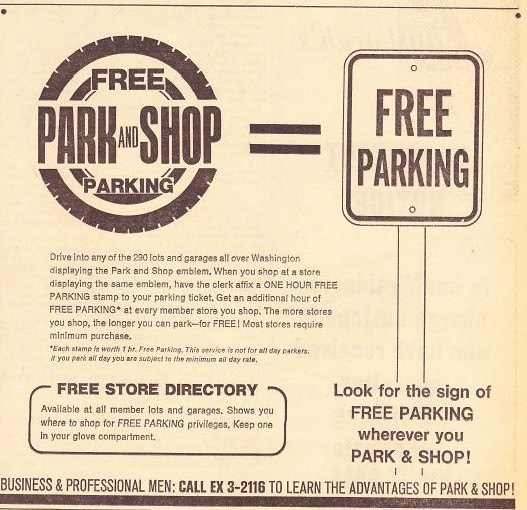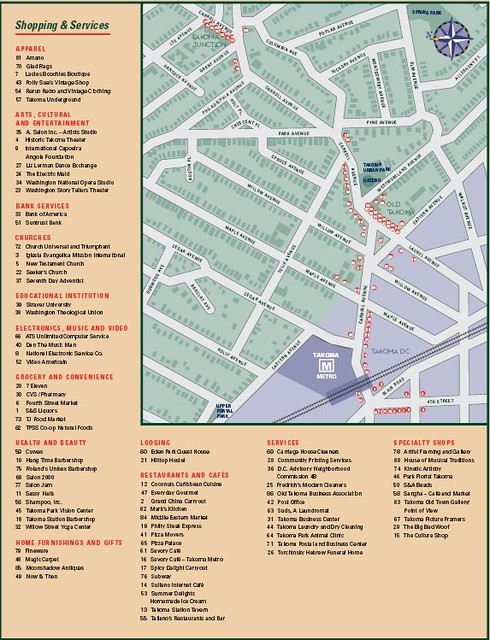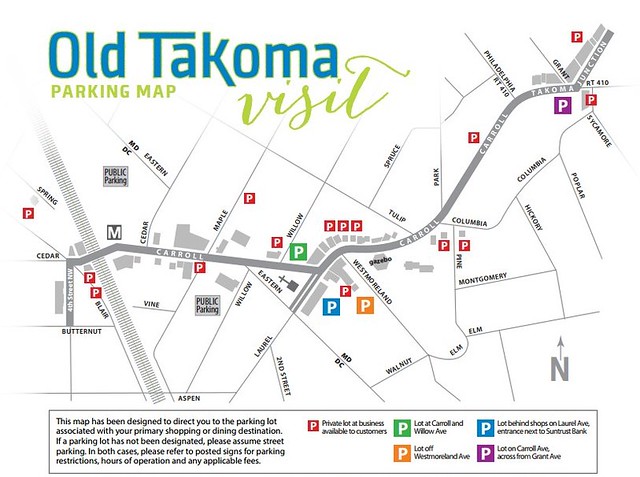Parking districts vs. transportation/urban management districts: Part two, Takoma DC/Takoma Park Maryland
The new Busboys & Poets restaurant in Takoma DC is located in the Takoma Central apartment building, which is located one block from the Takoma Metro Station and has no provision for commercial parking. One of the benefits of the new building is a much wider sidewalk.
Valentines Day was a great day for Greater Takoma, when the new Busboys & Poets opened to the public after more than one year of anticipation. An added bonus is a small bookstore as part of it, run by Politics & Prose.
But the building and the business doesn't provide parking, making it somewhat difficult or confusing for patrons to figure out what to do--accentuated of course by the cold temperatures of winter.
While I myself bike, walk, car share, or use transit to get around, not everyone does so and while we should endeavor to assist more people in using sustainable mobility modes, the reality is that commercial districts need to plan for parking. Takoma is no exception.
Parking space availability signage, Essen, Germany.
Many places have plenty of parking, but it's hard to use. I argue that many commercial districts "have enough parking," but usually it is broken up into separate parking lots where people are not allowed to "park once" and go on about their business.
Instead, parking lot users are supposed to limit their use of the lot to the time they spend within the businesses that control the lot. They are then expected to drive to their next destination and park there.
Another element of parking complexity is the failure to provide coordinated parking wayfinding systems, adequate signage and brochures, etc.
No DC municipal parking system. But there are some activity centers that don't have much parking. The pro-sustainable mobility part of me says "yes, screw the drivers." But that's pretty short-sighted from the standpoint of commercial district revitalization planning.
Unlike Montgomery County and their parking lot districts, which provide a set of public parking garages in destination districts like Bethesda and Silver Spring, DC had been prevented for many years from creating a system of municipal parking options, as a result of Congressional restrictions created at the behest of the private parking industry.
Generally, that's been a good thing, as the city has instead invested in transit.
And the city has tens of thousands of street parking spots serving commercial districts across the city.
Still, the reality is that automobility is a mode that many people use and needs to be planned for and accommodated at some level, especially in those commercial districts that get a goodly amount of patronage from people who drive--whether or not we plan for it, people will drive, so we might as well plan.
Places like Takoma, Tenleytown, Georgetown, H Street NE, and Capitol Hill need to provide better parking options than they do currently. But the city hasn't developed a method for addressing the need.
And we have to be careful in not building "too much" parking like what was done at DC/USA in Columbia Heights, where half of the parking structure went unused.
 Downtown Park and Shop ad, Washington Star, 4/10/1968.
Downtown Park and Shop ad, Washington Star, 4/10/1968.Shared parking as an opportunity. Except for downtown, most of DC's commercial districts have limited parking options except for what's present on the street. (Friendship Heights is a major exception.)
Coordinating the use of parking resources across a commercial district allows the resource to be better used, as was suggested by the concept of "mixed primary uses" in Death and Life of Great American Cities by Jane Jacobs.
More recently there have been some articles about the concept, in Planetizen ("Onsite Parking: The Scourge of America's Commercial Districts") and Urban Land Magazine ("Multiblock Underground Shared Parking").
ULI also has a book on the topic, which I have not read.
Parking map for Chestnut Hill, Philadelphia.
Best practice examples that come to mind are in College Park, Maryland, where certain private lots are metered with the revenues going to the city, as a way to limit the use of the lots as all-day parking for college students commuting to the University of Maryland and the Chestnut Hill district in Philadelphia, where a number of in-block parking lots are run by the Chestnut Hill Parking Foundation. The lots used to be free, but now are metered, which paid for paving the lots and other improvements.
Another is the North Park Main Street district in San Diego, where they have a system of valet parking serving the entire commercial district at various points, backstopped by a public parking garage.
Park and shop programs as an earlier form of shared parking. But this type of approach is not new. In response to shopping malls, many downtown business districts, including in DC, banded together to provide a coordinated parking system with a validation program that provided "free parking" for Downtown shoppers. The program lasted into the early 1970s.
I suppose with the decline of the relevance of Downtown in the face of the widespread development of suburban shopping malls the program finally fell apart.
"Park and Shop" programs were pioneered by a businessman an newspaper publisher in Allentown, Pennsylvania, who even created a game, Park and Shop, to demonstrate the project. See "Exhibit tells how Milton Bradley's Park & Shop game was invented" Allentown Morning Call.)
No regulatory framework to share parking. In DC, this is complicated by the fact that there is no regulatory framework for transportation coordination at the sub-city level, including for commercial districts, although by default in places where there are business improvement districts there is transportation coordination but not parking coordination in any substantive way.
DC's transportation plan parking element fails to adequately consider the need to coordinate all parking resources regardless of ownership status (public or private) and on-street or off-street.
DC needs transportation management districts. It happens I've argued for the creation of a framework for transportation management districts in the city for some time (including a proposed but rejected amendment to the Comprehensive Plan), but instead DC focuses on street parking management through various "performance parking pilot projects" (see "Testimony on parking policy in DC").
 This directory of the Old Takoma Business District is produced by the Main Street Takoma business association, and is posted on kiosks places.
This directory of the Old Takoma Business District is produced by the Main Street Takoma business association, and is posted on kiosks places.Takoma is an opportunity for DC (and Maryland) to pilot shared parking. (It'd be a little complicated as it would be cross-jurisdictional.) Parking demand spurred by Busboys & Poets has spurred spirited discussion on the neighborhood e-list about the lack of parking and the inconvenience of the building not providing parking.
But the reality is that there is plenty of parking, it's just that in the current paradigm, access is restricted to building users, even if much of the parking remains unused at night and on weekends--when it is needed most for night time oriented businesses.
Recently, I did a parking census of 12 public-serving surface parking lots in Takoma located between the Takoma Village Shopping Center on Carroll Avenue, the Strayer University campus on Laurel Avenue, and the Metro Station parking lot on Cedar Street. (In addition there are two indoor structures that I couldn't access.) Five of the lots are in Maryland, the rest in DC. The Metro lot is metered. Some of the lots charge and/or have forms of access control.
In a valet parking scenario, at least 25 additional spaces could be created in certain of the lots.
At night, these lots have a total of 474 unreserved parking spots. Two of the lots (and the structured parking) are within one block of Busboys and Poets and are minimally used at night.
Setting up a system in Takoma similar to the way the Chestnut Hill Parking Foundation operates could coordinate access to this set of parking lots and would strengthen the commercial district.
And it would make it a lot easier for patrons than the current system of disconnected parking lots.

Old Takoma parking map
Labels: car culture and automobility, commercial district revitalization planning, parking and curbside management, transportation management districts








11 Comments:
interesting that you included a picture of a parking facility in Essen- I have been there and to many other German towns and cities- they have munincipal parking garages just like this one- and most are located just outside of old city or town centers but an easy walk to them. The exception to this was in Cologne [ Koln] where there is a huge underground facility under the ancient corn market- also- Koln was heavily damaged during WW2 so it was rebuilt in a more car-centric fashion than other German cities. Now it is being rebuilt again- with more historicism in mind. When I was there last they were busy rebuilding the ancient city hall [ Rathaus] which was proximate to the old Jewish area and they were making new archaological finds on a constant basis. Many folks do not know it but Koln was for a long time the principal/largest city in Europe north of the Alps- it was a major city when London and Paris were all but abandoned in the dark ages so it has a very compelling history reaching back 2000 years.
wow. good to know. Another place to try to visit.
I was glad you chimed in on the listserv discussion detailing just how much parking there actually is in Takoma. We rarely drive downtown unless we're buying something heavy at the hardware store and so my impression has always been that too much space is dedicated to parking because as a pedestrian you spend a lot of time walking past mostly-empty expanses of asphalt; in contrast, when I'm driving I don't notice those as much because you're moving enough faster & focused on the road so any non-destination gets much less attention.
Getting more coordination seems like a great idea – simply putting up decent signage, which seems to be a regional blind-spot, would be a great start, particularly if we entered the modern era and explored e.g. signs to indicate available spots in a private lot during periods when a business or church isn't open.
one of the problems on the Maryland side is that towing companies have created a business for "enforcing" use requirements in parking lots "for businesses."
They pay the business for the privilege of enforcing the rules, and then can tow the cars deemed in violation and charge people a lot of money to release the cars.
I suppose property owners justify renting out their lots this way as a form of risk management, but it certainly doesn't engender a lot of goodwill with customers.
The parking lot for the Bank of America has this kind of restriction on it as an e.g. (and I was thinking, what if you own stock in BofA, and park there, and get towed. As a fractional owner of the business, could you have parking privileges.)
This comes up from time to time in Bethesda (has made it into the Post in the past, etc.).
2. wrt sharing resources, the city hasn't made it a priority or created a mechanism to not only bring property owners and commercial districts together but to ease the concerns of lot owners in terms of liability, etc.
Takoma would be a good place to pilot such coordination as it is a rare place with, as you point out, a lot of surface parking.
Although I expect over the next 15 years though, many of these lots will be redeveloped. It's happened with the Takoma Central building, is happening with the old Adventist lot behind CVS (now becoming housing), and will happen with the Metro lot (housing also).
I expect that at the edge of that time, buildings will be constructed on the lots on Willow/Laurel, which serve the office buildings there (Strayer, Douglas Development).
+1 the signage issue. There is parking everywhere, its just not always easy to locate and make decisions.
I am hoping that eventually private businesses/property owners can piggy back onto existing parking apps, and therefore have a payment mechanism. I don't have a problem paying for parking when I need it, and when traveling to out of town places, its nice to be able to know where/if parking is available.
I recently had a trip to Phil. and I spend almost an hour researching where parking garages were relative to my destination. The parking authority website was not helpful, and there was no information about on-street parking access and rates. The on-street parking info is on tiny signs, or at the payment kiosks. So the trick is you need park first, then find out if you can legitimately park there, then more often than not, move and try to find another place.
I wrote two plans for small town commercial districts, and parking wayfinding was a big element of the discussion. Later, in one of the towns, partly to get rid of loitering I think, they proposed to turn a park into a parking lot, even there was plenty of parking. An advocate found my planning document and was able to ward off the attempt.
The point you make about parking apps is interesting, the problem is that a lot of the places are so small.
2. wrt Philadelphia and the PPA, I once got a ticket for stuff, so I know what you mean.
Govt. agencies, even parking authorities, tend to be pretty bad at marketing.
sadly, I once had a shot at a planning job for a parking authority, but it was a management job and I didn't have enough experience "managing people"...
A well organized parking system is the requirement and it will make people convenient for parking their cars.
cheap airport parking
Parking is necessity for transportation and travellers feel much convenient when they see parking opportunities for their cars.
cheap airport parking
Nice post.
buyprescriptiondrugsonline.
Thanku for sharing information.
Best Party Bus Houston Service
Nice Blog. Thanks for sharing with us. Such amazing information.
11 Simple Lifestyle Changes To Feel More Energetic Every Day
MyBlogger Club
Guest Posting Site
Best Guest Blogging Site
Guest Blogger
Guest Blogging Site
Post a Comment
<< Home